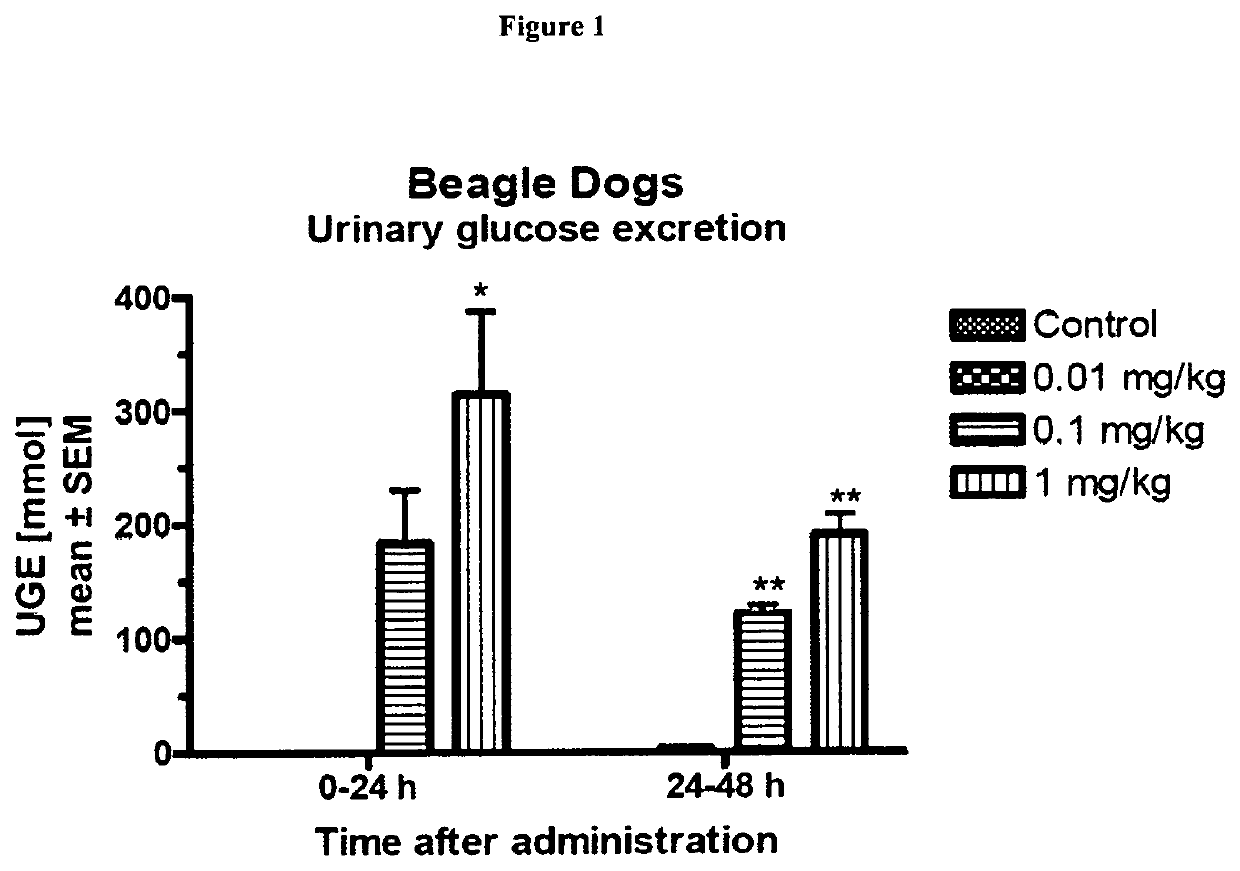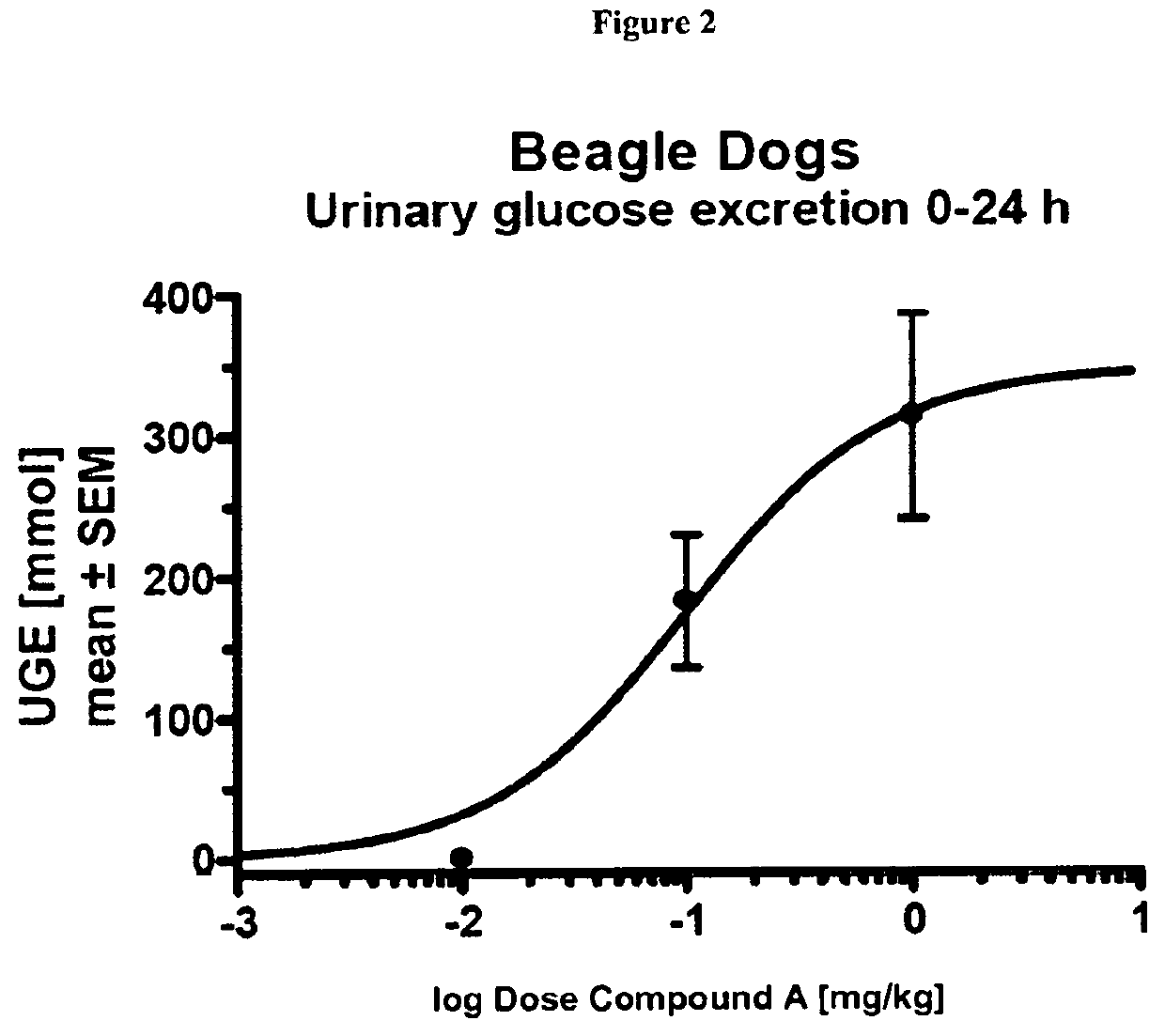Treatment of metabolic disorders in canine animals
a metabolic disorder and canine technology, applied in the field of veterinary medicine, can solve the problems of ineffective diabetic treatment, inability to conclude, and controversial autoimmunity in dogs, and achieve the effect of safe and effective treatment and/or prevention of metabolic disorders
- Summary
- Abstract
- Description
- Claims
- Application Information
AI Technical Summary
Benefits of technology
Problems solved by technology
Method used
Image
Examples
example 1
Pharmacokinetics (PK) of Compound a Single Oral Dosing in Dogs
[0251]Compound A was administered to overnight fasted dogs. The groups (n=4 per group) received a single administration of either oral vehicle (DI water) containing the SGLT2 inhibitor Compound A at a dose of 1 mg / kg and 10 mg / kg or intravenous vehicle (saline) containing the SGLT2 inhibitor Compound A at a dose of 1 mg / kg. PK measurements were taken until day 3 after a single administration of compound A or its vehicle.
[0252]
TABLE 2Pharmacokinetic data, single dose(i.v. 1 mg / kg, oral 1 and 10 mg / kg)Parameteri.v. 1 mg / kgp.o. 1 mg / kgp.o. 10 mg / kgtmax [hour]mean1.90.6Cmax [nmol / L]mean484551525CL [mL / min / kg]mean0.63CL / F [mL / min / kg]mean0.640.71F [%]mean10192AUC0→∞mean6702567675616750[nmol · h / l]T1 / 2 [hour]mean13.413.914.5
example 2
The Effect of Compound a on Urinary and Blood Glucose after Single Dosing in Dogs
[0253]Beagle dogs were fasted overnight and received a single oral administration of Compound A at doses of 0 mg / kg b.w., 0.01 mg / kg b.w., 0.1 mg / kg b.w., or 1 mg / kg b.w. (n=3 per group) followed by a rinsing with water (1 mL / kg b.w.)
[0254]Compound A was moistened with a small volume of a 1% (w / v) aqueous Polysorbat 80 (Tween80, Polyoxyethylene Sorbitan Monooleate, ICN Biomedicals) solution and then dissolved by slowly adding a large volume of a 0.5% (w / v) aqueous hydroxyethylcellulose (Natrosol 250 HX, Boehringer Ingelheim) solution and stirring at room temperature for about 15 minutes. The final concentration of Polysorbat 80 was 0.015%. Compound A was applied in a volume of 2 mL / kg. b.w.
[0255]The animals were kept individually in metabolic cages and received food 2 h after administration. They had free access to water during the experiment. Urine was collected in the time intervals 0-8 h, 8-24 h, 24-...
example 3
Treatment of Insulin Dependent Diabetes in Dogs
Treating Dogs with Insulin Dependent Diabetes
[0260]Insulin with the Compound A according to the invention or a combination of active substances according to the invention, in addition to producing an acute improvement in the glucose metabolic situation, prevents deterioration in the metabolic situation in the long term and reduces the insulin dose needed to treat the diabetic canine. This can be observed if dogs are treated for a shorter or longer period, e.g. 2-4 weeks or 3 months to 1 year, with the pharmaceutical composition according to the invention and are compared to the metabolic situation prior to treatment or with dogs that have been treated with e.g. insulin alone. There is evidence of therapeutic success if daily mean blood glucose and fructosamine level are reduced as compared to pre-treatment level. Further evidence of therapeutic success is obtained if a significantly smaller percentage of the dogs treated with a pharmace...
PUM
| Property | Measurement | Unit |
|---|---|---|
| body weight | aaaaa | aaaaa |
| body weight | aaaaa | aaaaa |
| mass | aaaaa | aaaaa |
Abstract
Description
Claims
Application Information
 Login to View More
Login to View More - R&D
- Intellectual Property
- Life Sciences
- Materials
- Tech Scout
- Unparalleled Data Quality
- Higher Quality Content
- 60% Fewer Hallucinations
Browse by: Latest US Patents, China's latest patents, Technical Efficacy Thesaurus, Application Domain, Technology Topic, Popular Technical Reports.
© 2025 PatSnap. All rights reserved.Legal|Privacy policy|Modern Slavery Act Transparency Statement|Sitemap|About US| Contact US: help@patsnap.com



